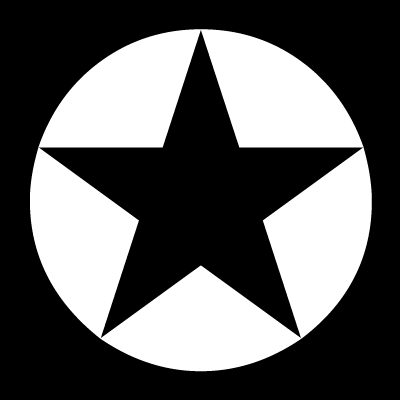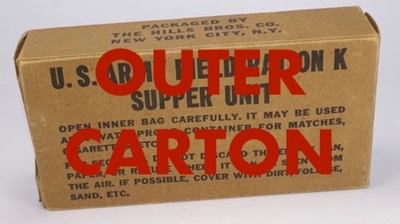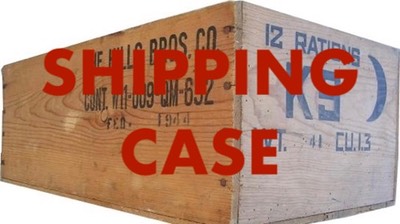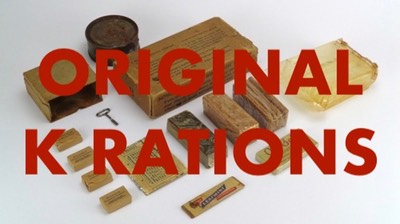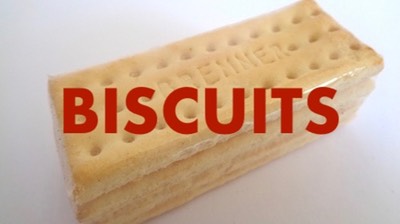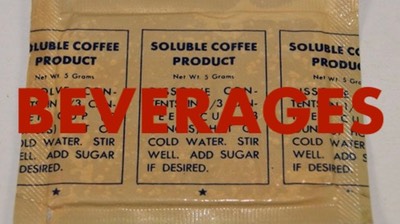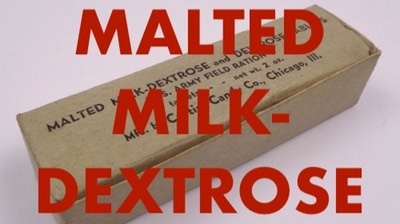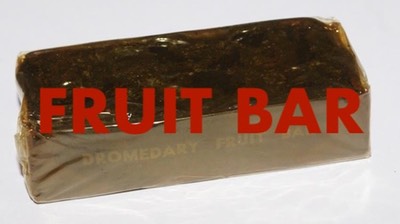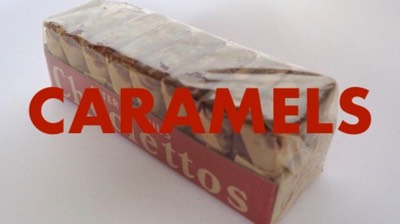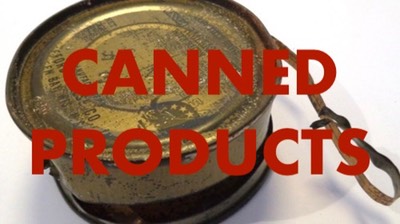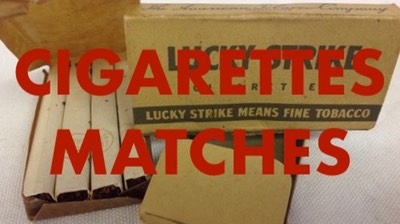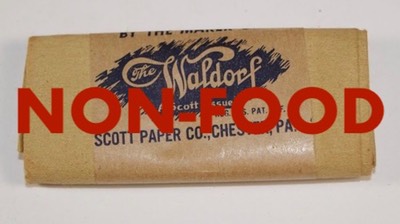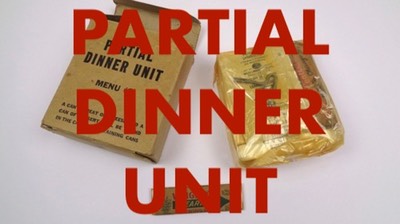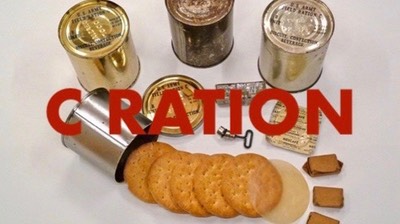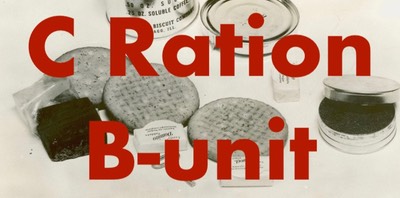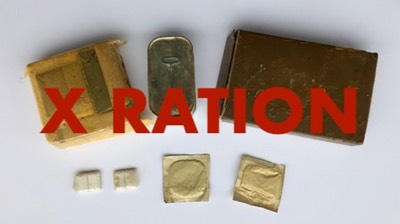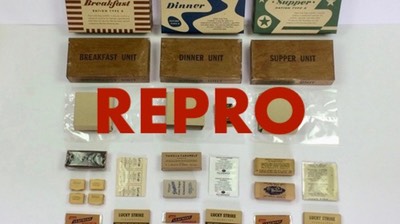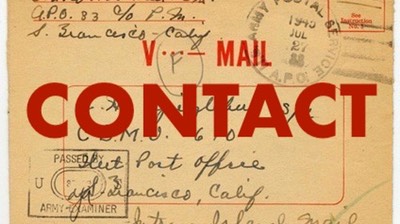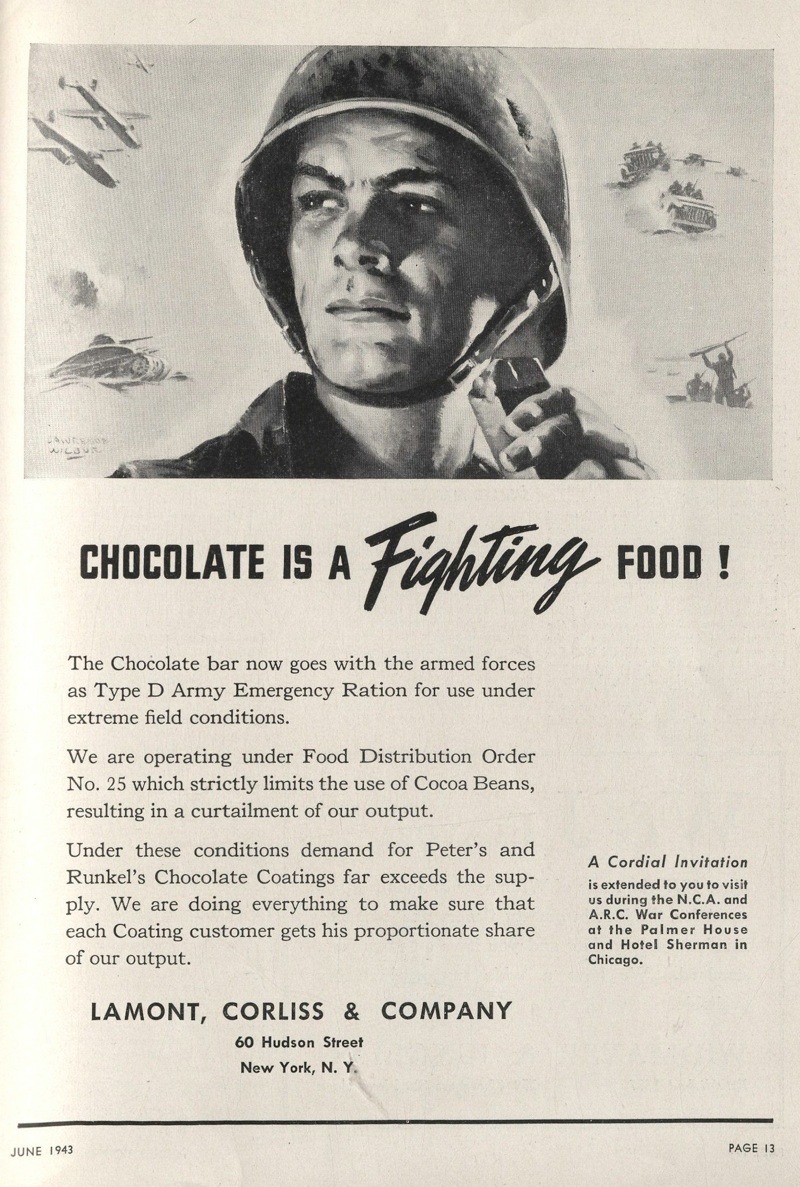
The D Bar is not identified as a chocolate bar. It, he says, is called a D Bar but nobody knows what a D Bar is. Everybody knows what a chocolate bar is. Therefore, why be mysterious about it.
D-bar
From the start of its development, the K Ration contained a 2-ounce chocolate bar in the Supper unit. It was of the same formula as the 4-ounce U.S. Army Field Ration D:
To aquire a higher melting point, the production of the chocolate differs from commercial process. The chocolate liquor is lightly mixed into a rough paste with the sugar and oat flour. Instead of running this mix through malingers, congers, rollers and other refining machines as is done in the commercial process, the mix is kept rough. The chocolate made with this rough mix will not run and therefor cannot be poured, not even when heated and is forced with great pressure into the moulds.
The 2-ounce D-bar was practically a standard 4-ounce D Ration cut in half lengthwise. (Hence its 3 15/16" length.)
The size of the early D-bar was 3 15/16 x 1 1/8 x 7/8 inch. The lenght of the bar protruded past the biscuits and sometimes caused the cellophane bag to burst.

Early 3 15/16" long D-bar made by Hershey.

An original mould for the early 2-ounce D-bar. This mould was made for Hershey by the "American Chocolate Mould Co. Inc.”.
The two D-bars are resin casts from this mould. (mould courtesy L. Kelatow)

An early 3 15/16" long D-bar with ingredients printed on the front of the wrapper.

An early 3 15/16" long D-bar, without any ingredients listed.
In March of 1943 the D-bar was shortened to 3 1/8 inch due to the problems encountered with damaged cellophane bags. Still being of the 2-ounce weight its new dimensions were not to exceed 3 1/8" long, 1 9/32" wide and 13/16" high.

The new 3 1/8" D-bar made by Peter, Cailler, Kohler Swiss Chocolates Co.* (photo: 1944Supply)
Sweet Chocolate bar
As with the D Ration, the 2-ounce D-bar was a bitter and hard chocolate bar. In the fall of 1943 a more palatable sweet chocolate bar was developed and replaced the less popular D-bar.
First specification dated 15 Januari 1944.
Although basically the same as the D-bar formula, the amount of sugar was increased and the oat flour was omitted. Just like the D Ration, the Sweet Chocolate bar became harder upon aging.
In 1944 a slightly new formula and processing method was developed that made a superior chocolate bar that actualy became softer during longer storage without melting in warmer climates. Because of the difficult manufacturing proces and development of new processing machinery, production of this new chocolate bar only got well under way at the end of the war.
As with the 4-ounce D Ration a warning was added to the wrapper that during storage the chocolate might develop a white “blooming” on its surface due to warm climate conditions. This was caused by “oiling off” or “sweating” of the cocoa fat.
It was reported from the frontlines (especially in the pacific theatre) that the soldiers tended to throw away the affected bars. This blooming is, however, harmless and does not effect its nutricial qualities or taste.

A 2-ounce sweet choclate bar (3 1/8" length), with ingredients listed on its wrapper. Manufactured by Rockwood & Co. (photo: 1944Supply)

Another 2-ounce Sweet Chocolate Bar also made by Rockwood.
The label is of the continuous printed type. This means that the text repeats itself and there is no specific positioning of the wrapper around the bar. Note that the label is printed with brown/purple-ish ink. (Photo: 1944Supply)

A 2-ounce sweet choclate bar (3 1/8" length), Note the warning about whitening on its side. (photo: 1944Supply)

The 2-ounce sweet chocolate bar (3 1/8") made by Peter, Cailler, Kohler Swiss Chocolates Co.* (photo: 1944Supply)

A more attractive design for the Sweet Chocolate bar produced by Rockwood & Co. This might be the version manufactured with the new formula that produced a softer, more palatable chocolate bar (photo: 1944Supply)
Although popular with the troops it was found that the size was still too big and hard to bite through in cold climates. In December 1944 specifications notes that two 1-ounce sweet chocolate bars replaced the 2-ounce bar.

A 1-ounce Nestlé's* chocolate bar. (From a mid 1945 Supper unit.) Two of these, or one package of caramels, replaced the 2-ounce sweet chocolate bar in the Supper units. (photo: 1944Supply)
Chocolate Candy bar
The inclusion of commercial candy bars was not found possible due to the poor keeping qualities of the chocolate products onder warm conditions above 85ºF (29.5ºC). Also, readily available commercial candy bars came in sizes not practical for ration use.
To remedie the low melting point of the chocolate outer coating, an artificial choclate coating was developed that looked like choclate (made of hydrogenated vegetable oil, sugar and cocoa) and thereby keeping the attractiveness of the candy, that would have a higher melting point. Although the coating contained only 20% cocoa fat it was practically tasteless. Due to the flavourful centers of this type of candy it was used with this was acceptable.

The Mars company went out of their way to develop a version of their candy bars that could with stand hot climates but the coating was still made with real chocolate. Also, the caramel nougat filling was made more stiff by altering the formula. These bars can be identified by the addition of the words “Torrid Zone”. The same goes for the Mars caramel fudge bars. (photo courtesy S.J. Schmalstieg)
In the fall of 1944 the caramels in the Dinner unit were replaced by a candy bar. It appears that the caramel nougat "Milky Way" bar made by Mars was used with the majority of the K Rations since the specifications were changed.

A "Milky Way" caramel nougat bar replaced the caramel candies in the Dinner unit. (This one came from an early 1945 Dinner unit still packed in a Type IVa outer carton.)
The words Torrid Zone refers to the fact that the candy bar has a higher melting point for use in the tropics.
As an alternative to the "Milky Way" bar in some K Rations is the "Mars" bar made by the same company. This confection was also used in the 10-in-1's Partial Dinner Units.

The "Mars" bar as it was included as a confection in late war Dinner units. Again note the words Torrid Zone superimposed on the Mars logo. (photo: 1944Supply)
Interestingly, the wrapper on my own example wasn’t sealed in any way. The glassine wrapper was placed loosely around the candy bar and the ends were then folded underneath the bar.
However, the wrappers on other Mars produced candy bars found in the K rations have been sealed. As was experienced with the Sweet Chocolate bars, the cocoa fat would melt in high temperatures and leak out of the grease proof wrapper. To remedy this it was instructed that all seams of the wrappers were to be sealed.
My example might have been an early procurement (the outer cartons was the older Type IVa) where the candy bars were loosely wrapped as was commercial practice. This would have soon be corrected to follow the official directions.


Wartime advertisement for the Milky Way bar made by Mars.
Note the yellow star of the commercial wrappings in contrast to the white stars used with the Torrid Zone Milky Ways.
As an alternative to the Mars bars, the Curtiss Candy Co. produced their Jolly Jack candy bar for inclusion in Army rations. This candy bar was produced in a size making it suitable for inclusion in the K Ration, with the chocolate formula slightly altered to give it a higher melting point.
It appears that the initial production was packaged in a glassine paper wrapping. This was later changed to a heat seal cellophane bag with a label, printed on glassine paper, adhere to the cellophane packed candy bar after sealing. This packaging method was probably better suited for mass production.
All the known Jolly Jack candy bars that were found in K Rations are from 1945.

A Jolly Jack candy bar made by Curtiss Candy Co. found in an early 1945 Dinner unit. The wrapper is glassine paper and appears to be a misprint, simply missing the red printing that would read "Jolly Jack”. Note that the blue text is the same as the Jolly Jack candy bar pictured bellow with the separate label. The red blotches might be a result from the faulty printing. (photo courtesy S.J. Schmalstieg)

The Curtiss Candy Co. Jolly Jack candy bar heat sealed in cellophane bag. Note that a separately printed label is adhered to the cellophane bag.
This one is from a 1945 Dinner unit packed by the Doughboy Mills Inc. (photo courtesy S.J. Schmalstieg)

A kind of chocolate candy bar was found in a 1945 Dinner unit. This might be a Jolly Jack candy bar, as pictured above, without its label. (photo: 1944Supply)
Hershey’s Tropical Chocolate bar
After a request of the Procurement Division of the US Army for a confectionary chocolate bar with a higher melting point in 1943, the Hershey Company developed a new formula for a chocolate bar for use in the tropics and marketed these under the name "Hershey's Tropical Chocolate”.
The word Tropical was printed in red. The ingredients were basicly the same as the D-bar, but sweeter. The 2-ounce bar is of the same dimensions as the shorter D-bar.
Since oat flour was still used as an ingredient, it can be assumed that this chocolate bar was introduced before the Sweet Chocolate bar. It was not used in any Army’s field rations, but it was used in other subsistance kits produced for by the Navy and Army Air Force. It was also available to the soldiers through the PX stores.

A 2-ounce Tropical chocolate bar. This bar was not used with the K Ration or any other Army field ration. These bars, however, were used by the USAAF and USN in several of their emergency/survival ration kits.
According to the Hershey’s Community Archives this bar was produced in 1-ounce and 2-ounce sizes. At the end of World War Two almost 380 million 2-ounce bars were produced by Hershey for the military.
Note that under the name Hershey’s, there is a line of small letter font reading “Reg. U. S. Pat. Off.” meaning that the name Hershey's is registered at the US Patent Office.
These bars continued to be produced after the war and in 1947 the color of the word Tropical changed from red to blue. Later, in 1957, the formule was changed, omitting the oat flour. It is probably that during this period the “Reg. U.S. Pat. Off.” was changed to ®.

According to the Hershey Community Archives the text changed to blue in 1947.

A Hershey's tropical 1-ounce bar having the ® added to the label. This might coincide with the changes in the formula.
* Nestlé and the Peter, Cailler, Kohler Swiss Chocolates Co. (hereafter PCK) are two different companies. Both companies are from Switzerland and have been working together for years since the early 1900’s.
PCK made chocolate bars for Nestlé and mentions that fact (Made by the makers of Nestlé’s chocolate bars) on the label, but the recipe is the one developed by the army. When chocolate bars were used that were of Nestlé’s own commercial recipe the label does says "Nestlé’s Sweet Chocolate Bar” like the 1-ounce bar pictured. These were also made by PCK for Nestlé. Lamont, Corliss & Company also made chocolate bars for Nestlé.
